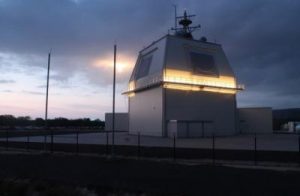The Japanese Ministry of Defense (MoD) awarded a contract to U.S. defense firm Lockheed Martin for the production and delivery of two Solid State Radar (SSR) antenna sets for its planned two land-based Aegis Ashore missile defense batteries, the land-based variant of the Aegis combat system for defense against ballistic and cruise missiles, it plans to install in the 2020s, the company said in a November 20 statement.
The SSR, designated by the U.S. government as AN/SPY-7(V)1, will be integrated with the Aegis Ashore system and provide Japan with a “robust system” that can “detect, track and engage sophisticated ballistic missile threats, provides several times the detection range and sensitivity of traditional SPY-1 Aegis Ashore systems, and engages multiple targets simultaneously with proven interceptors,” according to Lockheed Martin.
Japan selected the SSR in July 2018 over Raytheon’s SPY-6 radar system due to the SSR’s lower lifecycle costs, better overall system performance including more sophisticated target discrimination capabilities and cheaper acquisition and operating costs in comparison to the SPY-6, according to the Japanese MoD at the time. Last July, I cited a possible other reason for the decision:
One of the most likely explanations why Japan picked the SSR over SPY-6 is the former’s earlier availability. The SPY-6 will likely not be ready for export before 2024 or 2025.
Yet, I also noted the following caveat:
However, Japan wants to deploy both Aegis Ashore batteries by 2023, although the July 30 MoD statement noted that it will take six years from the signing of the contract to the operational deployment of the two batteries, which could mean that the batteries might not be operational until 2024 or 2025 after all.
The SSR system is based on the same architecture as Lockheed Martin’s still-in-development Long Range Discrimination Radar (LRDR), designed for the U.S. Ground-Based Midcourse Defense (GMD) system, to defend the continental United States from long-range ballistic missile attacks.
The Aegis Ashore sites will be capable of firing the SM-3 Block IIA/Block IB interceptors as well as the supersonic SM-6 missile interceptors. The batteries are are expected to be stationed in Japan’s Akita and Yamaguchi prefectures.
“The combat system for Aegis Ashore Japan will be compatible with the country’s current Aegis naval fleet for full interoperability,” Lockheed Martin states. “As the threat environment evolves, Aegis Ashore Japan will be updated from the same Common Source Library (CSL) of software updates that all Aegis assets utilize.” Japan’s latest destroyers are fitted with the Aegis Baseline J7 combat system, the Japanese equivalent to the U.S. Navy’s Baseline 9/BMD 5.1 standard Aegis combat system.
Lockheed Martin did not provide details about the value of the contract or the delivery schedule. Acquisition and installation costs of the SSR systems will be around $2.3 billion, while maintenance and operational costs are estimated at around $4.18 billion over 30 years, according to the MoD.
































